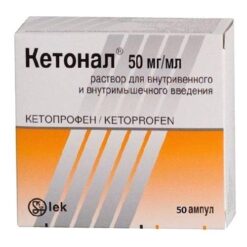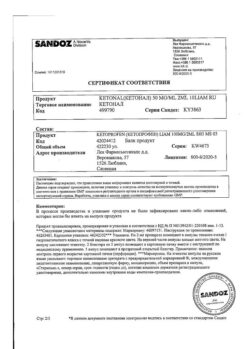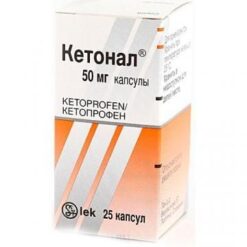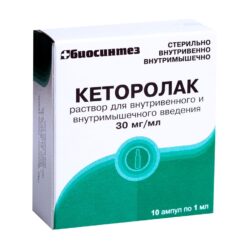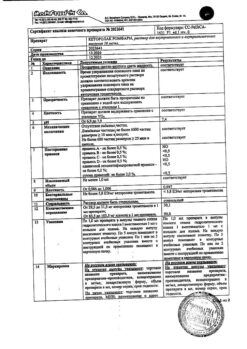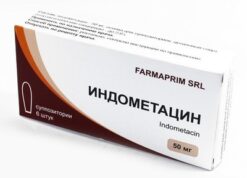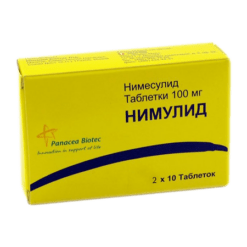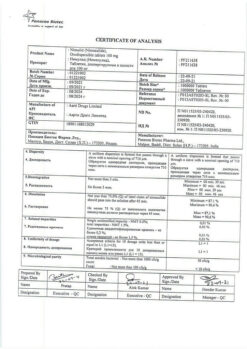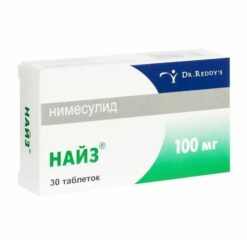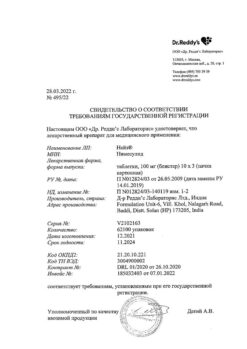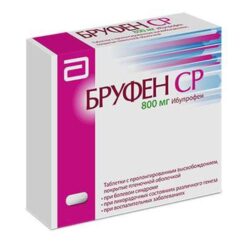No products in the cart.
Myrlox, 15 mg tablets, 20 pcs.
€1.00
Out of stock
(E-mail when Stock is available)
Description
Pharmgroup:
NSAIDs.
Pharmaceutical action:
Mirlox is a non-steroidal anti-inflammatory drug (NSAID). It has anti-inflammatory, analgesic and antipyretic effects.
The anti-inflammatory effect is associated with inhibition of COX-2 enzymatic activity, which is involved in the biosynthesis of prostaglandins in the inflamed area. To a lesser extent, it acts on COX-1, which is involved in the synthesis of prostaglandin, which protects the mucous membrane of the digestive tract and is involved in the regulation of blood flow in the kidneys.
Pharmacokinetics:
Intake
After oral administration is well absorbed from the gastrointestinal tract. The absolute bioavailability of meloxicam is 89%. Simultaneous intake of food does not change absorption.
When Mirlox is taken orally in doses of 7.5 mg and 15 mg the plasma concentration of meloxicam is proportional to the dose.
The range of difference between Cmax and Cmin in plasma after a single dose is relatively small and with a dose of 7.5 mg is 0.4-1 mcg/ml, and with a dose of 15 mg – 0.8-2 mcg/ml (the values of both Cmin and Cmax are given, respectively).
Distribution
Css is reached within 3-5 days. With long-term use of the drug (more than 1 year), concentrations are similar to those observed after first reaching the equilibrium state.
The binding to plasma proteins is more than 99%. Vd is small and averages 11 liters.
Meloxicam penetrates through the histohematic barriers, the concentration in synovial fluid reaches 50% of the Cmax of the drug in plasma.
Metabolism
Meloxicam is almost completely metabolized in the liver to form 4 pharmacologically inactive metabolites. The main metabolite, 5′-carboxymeloxicam (60% of the dose taken), is formed by oxidation of the intermediate metabolite, 5′-hydroxymethylmeloxicam, which is also excreted, but to a lesser extent (9% of the dose taken). In vitro studies have shown that CYP2C9 isoenzyme plays an important role in this metabolic transformation, CYP3A4 isoenzyme has additional importance. Peroxidase, the activity of which probably varies individually, is involved in the formation of the other two metabolites (which are 16% and 4% of the dose of the drug, respectively).
Elimation
T1/2 of meloxicam is 15-20 h. It is excreted in the feces and urine, mainly as metabolites. Less than 5% of the daily dose is excreted unchanged in the feces, the drug is excreted unchanged in the urine only in trace amounts. Plasma clearance is on average 8 ml/min.
Pharmacokinetics in special clinical cases
The clearance of Mirlox is decreased in elderly persons.
Hepatic or renal insufficiency of moderate severity has no significant effect on the pharmacokinetics of meloxicam.
Indications
Indications
– symptomatic treatment of osteoarthritis;
– symptomatic treatment of rheumatoid arthritis;
– symptomatic treatment of ankylosing spondylitis (ankylosing spondylitis).
Pharmacological effect
Pharmacological effect
Pharmgroup:
NSAIDs.
Pharmaceutical action:
Mirlox is a non-steroidal anti-inflammatory drug (NSAID). It has anti-inflammatory, analgesic and antipyretic effects.
The anti-inflammatory effect is associated with inhibition of the enzymatic activity of COX-2, which is involved in the biosynthesis of prostaglandins in the area of inflammation. To a lesser extent, it affects COX-1, which is involved in the synthesis of prostaglandin, which protects the mucous membrane of the digestive tract and takes part in the regulation of blood flow in the kidneys.
Pharmacokinetics:
Suction
After oral administration, it is well absorbed from the gastrointestinal tract. The absolute bioavailability of meloxicam is 89%. Concomitant food intake does not alter absorption.
When taking the drug Mirlox orally in doses of 7.5 mg and 15 mg, the concentration of meloxicam in the blood plasma is proportional to the dose.
The range of differences between Cmax and Cmin in blood plasma after a single dose is relatively small and at a dose of 7.5 mg is 0.4-1 µg/ml, and at a dose of 15 mg – 0.8-2 µg/ml (both Cmin and Cmax values are given respectively).
Distribution
Css is achieved within 3-5 days. With long-term use of the drug (more than 1 year), concentrations are similar to those observed after the first achievement of an equilibrium state.
Plasma protein binding is more than 99%. Vd is small and averages 11 liters.
Meloxicam penetrates histohematic barriers, the concentration in synovial fluid reaches 50% of the Cmax of the drug in blood plasma.
Metabolism
Meloxicam is almost completely metabolized in the liver to form 4 pharmacologically inactive metabolites. The main metabolite, 5′-carboxymeloxicam (60% of the dose taken), is formed by oxidation of an intermediate metabolite, 5′-hydroxymethylmeloxicam, which is also excreted, but to a lesser extent (9% of the dose taken). In vitro studies have shown that the CYP2C9 isoenzyme plays an important role in this metabolic transformation; the CYP3A4 isoenzyme is of additional importance. Peroxidase, the activity of which probably varies individually, takes part in the formation of the other two metabolites (constituting 16% and 4% of the drug dose, respectively).
Removal
T1/2 of meloxicam is 15-20 hours. It is excreted equally in feces and urine, mainly in the form of metabolites. Less than 5% of the daily dose is excreted unchanged in feces; the drug is found unchanged in urine only in trace amounts. Plasma clearance averages 8 ml/min.
Pharmacokinetics in special clinical situations
In elderly people, the clearance of Mirlox is reduced.
Moderate hepatic or renal impairment does not significantly affect the pharmacokinetics of meloxicam.
Special instructions
Special instructions
The drug should be used with caution in patients with a history of gastric and duodenal ulcers, as well as in patients receiving anticoagulant therapy. Such patients have an increased risk of erosive and ulcerative lesions of the gastrointestinal tract.
The drug should be used with caution and under monitoring of renal function indicators in elderly patients, patients with chronic heart failure with symptoms of circulatory failure, in patients with liver cirrhosis, as well as in patients with hypovolemia as a result of surgical interventions.
In case of renal failure, if CC is more than 25 ml/min, no adjustment of the dosage regimen is required.
In patients on dialysis, the maximum dose of the drug is 7.5 mg/day.
Patients taking diuretics and meloxicam simultaneously should receive sufficient fluids.
If allergic reactions (itching, skin rash, urticaria), as well as photosensitivity, occur during treatment, the patient should consult a doctor to decide whether to stop taking the drug.
Use for liver dysfunction: Contraindicated in severe liver failure.
Use for impaired renal function: In patients with an increased risk of side effects, as well as in patients with severe renal failure on hemodialysis, the dose should not exceed 7.5 mg/day.
Effect on the ability to drive vehicles and operate machinery: The use of the drug may cause undesirable effects such as headaches, dizziness, and drowsiness. If the above phenomena occur, it is necessary to stop driving vehicles and servicing machines and mechanisms.
Active ingredient
Active ingredient
Meloxicam
Composition
Composition
1 tablet contains:
Meloxicam 15 mg
Excipients:
Lactose,
corn starch,
sodium citrate,
maltodextrin,
crospovidone micronized,
magnesium stearate.
Pregnancy
Pregnancy
The drug is contraindicated for use during pregnancy and lactation.
Contraindications
Contraindications
– “Aspirin” asthma.
– Peptic ulcer of the stomach and duodenum in the acute phase.
– Severe liver failure.
– Severe renal failure (if hemodialysis is not performed).
– Children under 15 years of age.
– Pregnancy.
– Lactation (breastfeeding).
– Hypersensitivity to the components of the drug.
The drug should be used with caution in elderly patients with a history of erosive and ulcerative lesions of the gastrointestinal tract.
Side Effects
Side Effects
From the digestive system: nausea, vomiting, abdominal pain, diarrhea, constipation, flatulence, erosive and ulcerative lesions of the gastrointestinal tract, perforation of the stomach or intestines, gastrointestinal bleeding (latent or obvious), increased activity of liver enzymes, hepatitis, colitis, stomatitis, dry mouth, esophagitis.
From the cardiovascular system: tachycardia, increased blood pressure, feeling of hot flashes.
From the respiratory system: exacerbation of bronchial asthma, cough.
From the central nervous system: headache, dizziness, tinnitus, disorientation, confusion, sleep disturbance.
From the urinary system: edema, interstitial nephritis, renal medullary necrosis, urinary tract infection, proteinurnia, hematuria, renal failure.
From the organ of vision: conjunctivitis, blurred vision.
From the hematopoietic system: anemia, leukopenia, thrombocytopenia.
Dermatological reactions: itching, skin rash, increased photosensitivity.
Allergic reactions: urticaria, anaphylactoid reactions (including anaphylactic shock), swelling of the lips and tongue, allergic vasculitis, erythema multiforme exudative (including Stevens-Johnson syndrome), toxic epidermal necrolysis (Lyell’s syndrome).
Other: fever.
Interaction
Interaction
When used simultaneously with other NSAIDs (as well as with acetylsalicylic acid), the risk of erosive and ulcerative lesions and bleeding from the gastrointestinal tract increases.
When used simultaneously with antihypertensive drugs, the effectiveness of the latter may be reduced.
When used simultaneously with lithium preparations, the development of accumulation of lithium and an increase in its toxic effect is possible (monitoring the concentration of lithium in the blood is recommended).
When used simultaneously with methotrexate, the latter’s side effect on the hematopoietic system increases (the risk of anemia and leukopenia; periodic monitoring of a general blood test is indicated).
When used simultaneously with diuretics and cyclosporine, the risk of developing renal failure increases.
When used simultaneously with intrauterine contraceptives, the effectiveness of the latter may decrease.
When used simultaneously with anticoagulants (heparin, ticlopidine, warfarin), as well as with thrombolytic drugs (streptokinase, fibrinolysin), the risk of bleeding increases (periodic monitoring of blood coagulation parameters is required).
When used simultaneously with cholestyramine, as a result of binding of meloxicam, its excretion through the gastrointestinal tract increases.
Overdose
Overdose
Symptoms: impaired consciousness, nausea, vomiting, epigastric pain, gastrointestinal bleeding, acute renal failure, liver failure, respiratory arrest, asystole.
Treatment: gastric lavage, taking activated charcoal (within the next hour after administration), carrying out symptomatic therapy. Cholestyramine accelerates the elimination of meloxicam from the body. Forced diuresis, alkalization of urine, and hemodialysis are ineffective due to the high binding of meloxicam to blood proteins. There is no specific antidote.
Storage conditions
Storage conditions
In a dry place, protected from light, at a temperature not exceeding 25 °C
Shelf life
Shelf life
2 years
Manufacturer
Manufacturer
Polfa Warsaw Pharmaceutical Plant, Poland
Additional information
| Shelf life | 2 years |
|---|---|
| Conditions of storage | In a dry, light-protected place at a temperature not exceeding 25 °C |
| Manufacturer | Polfa Warsaw Pharmaceutical Plant, Poland |
| Medication form | pills |
| Brand | Polfa Warsaw Pharmaceutical Plant |
Related products
Buy Myrlox, 15 mg tablets, 20 pcs. with delivery to USA, UK, Europe and over 120 other countries.


